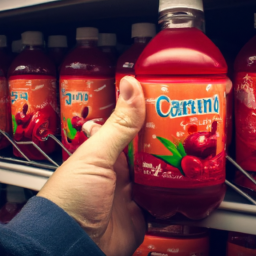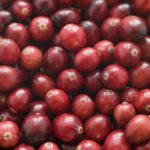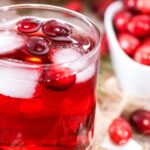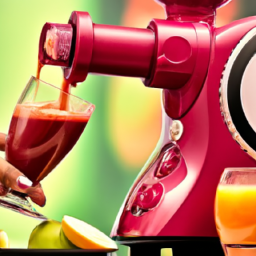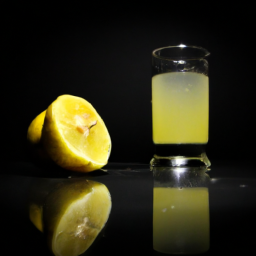With a taste that is both tart like an unripe apple yet sweet like a ripe strawberry, cranberry juice has always been a favorite for many. With its numerous health benefits, it’s no wonder that more and more people are looking to try it. But the question remains: where can you find the best cranberry juice?
In this article, I will explore the different types of cranberry juice, where you can buy it, and compare prices to help you make an informed decision. Cranberry juice is known for its ability to prevent urinary tract infections, improve heart health, and boost the immune system. It’s no wonder that it’s a staple in many households.
But with so many options on the market, it can be difficult to know which one to choose. Whether you prefer pure cranberry juice or a blend with other fruits, there’s a type of cranberry juice for everyone. In this article, I will discuss the different types available and where you can find them.
So, sit back, relax, and let’s dive into the world of cranberry juice.
Key Takeaways
- Cranberry juice can be purchased at specialty stores, independent markets, and online retailers such as Amazon, Walmart, and Target.
- Prices for cranberry juice may vary depending on the region and availability, so comparing prices across retailers can help save money and ensure the desired product is found.
- There are different types of cranberry juice, including pure cranberry juice and cranberry juice cocktails, which may contain added sugar.
- Making fresh cranberry juice at home is possible by blending washed cranberries with water and sweetener, and natural sweeteners such as honey, agave nectar, and maple syrup can be used. However, it’s important to consult with a healthcare professional before making significant dietary changes and consider any potential health concerns when adding sweeteners or mixing with other juices.
Benefits of Cranberry Juice
You’ll love how cranberry juice can improve your health and leave you feeling refreshed! One of the most well-known benefits of cranberry juice is its ability to prevent urinary tract infections (UTIs). Cranberry juice contains compounds called proanthocyanidins, which have been shown to prevent bacteria, such as E. coli, from sticking to the walls of the urinary tract. This makes it harder for the bacteria to multiply and cause an infection.
But that’s not all. Cranberry juice is also packed with antioxidants, which help protect your cells from damage caused by free radicals. These free radicals can lead to chronic diseases such as cancer, heart disease, and Alzheimer’s. Drinking cranberry juice can also help improve your digestion, boost your immune system, and even promote healthy skin.
Now that you know about the many cranberry juice health benefits, let’s explore the different types of cranberry juice available on the market.
Different Types of Cranberry Juice
There’s a whole world of tart and sweet flavors waiting for you in the cranberry aisle, from the crispness of white cranberry to the depth of dark cranberry blends.
Each type of cranberry juice offers its unique taste, color, and health benefits.
For instance, cranberry juice cocktails are a popular choice for people who want to enjoy the tartness of cranberries while also indulging in a sweet taste.
These mixes often contain added sugar, so it’s important to read the label carefully before purchasing.
Aside from cranberry juice cocktails, there are also pure cranberry juices that provide numerous health benefits.
Cranberries are known for their high levels of antioxidants and anti-inflammatory properties.
Drinking cranberry juice regularly may help prevent urinary tract infections, reduce the risk of heart disease, and improve digestive health.
With so many options available, it’s easy to find a cranberry juice that suits your taste and health needs.
Speaking of which, have you ever wondered where to buy them?
Local Supermarkets
When I’m looking for cranberry juice, I typically start my search at local supermarkets. These stores usually carry a variety of national chains, specialty stores, and independent markets.
Each type of store offers its own unique selection of cranberry juice, so it’s worth exploring all of your options to find your favorite brand or flavor.
National Chains
Major retailers like Walmart and Target carry cranberry juice in their beverage aisle, offering a variety of brands and sizes, including regular and sugar-free options. It’s a convenient option for those wanting to incorporate it into their diet.
While convenience stores and gas stations may have limited selection and higher prices, it’s best to check with the specific store beforehand. Specialty stores may be a better option for a wider selection of cranberry juice.
Specialty Stores
Specialty stores offer a unique shopping experience for those seeking high-quality and hard-to-find items, including a wide range of options for those looking to incorporate cranberries into their diet. These stores often prioritize sustainability and source their products from local and organic farms. This is particularly important when it comes to cranberry juice, as the production process can be resource-intensive and have negative impacts on the environment.
When shopping at specialty stores, consumers can find cranberry juice that has been produced using sustainable methods, such as water-efficient irrigation and responsible waste management. Additionally, many specialty stores offer a variety of cranberry juice options, including fresh-pressed, organic, and naturally sweetened varieties. By choosing to shop at these stores, individuals can support sustainable and ethical practices in the food industry while also enjoying high-quality and delicious cranberry juice.
Moving on to independent markets, shoppers can find even more unique and locally-sourced options for cranberry juice.
Independent Markets
If you’re on the lookout for unique and locally-sourced options, independent markets can be a great choice for your next shopping trip. These markets often specialize in sourcing products from small, local farms and producers, which means you’re likely to find products that you won’t find anywhere else.
Additionally, by shopping at independent markets, you’re supporting local businesses and the local economy. When it comes to pricing, independent markets may not always be the cheapest option, but they often offer a better value in terms of quality and unique offerings. Plus, it’s important to keep in mind that by choosing to shop at these markets, you’re supporting a more sustainable and ethical food system.
So, if you’re looking for high-quality cranberry juice and want to support local businesses, consider checking out your nearest independent market. As convenient as it can be to order products online, sometimes nothing beats the experience of browsing a physical store. However, if you’re not able to find what you’re looking for at an independent market, the next step is to check out online retailers.
Online Retailers
You can easily find cranberry juice online from retailers like Amazon, Walmart, and Target. These online retailers offer a variety of cranberry juice brands and flavors, allowing you to choose the one that best suits your taste. Additionally, many of these retailers have customer reviews available, giving you the opportunity to read about other people’s experiences with the product before making a purchase.
When it comes to shipping options, most online retailers offer a variety of choices, including standard and expedited shipping. Some retailers may also offer free shipping for orders over a certain amount. It’s important to check the shipping options and costs before making a purchase to ensure that you receive your cranberry juice in a timely and cost-effective manner.
With so many options available, it’s easy to find cranberry juice online that fits your needs and budget.
Moving on to the next section about comparison of prices, it’s important to note that while online retailers may offer competitive prices, it’s always a good idea to compare prices across different retailers to ensure that you’re getting the best deal possible.
Comparison of Prices
When shopping for groceries online, I always make sure to compare the prices of different retailers to get the best deal. This is particularly important when it comes to cranberry juice, as prices can vary widely depending on the region and the availability of the product.
Some retailers may offer a better deal on a particular brand or size of cranberry juice, while others may have discounts or promotions that can save you money. It’s also worth noting that availability of cranberry juice can vary depending on where you live.
Some regions may have a wider selection of brands or sizes, while others may only carry a limited selection or none at all. By comparing prices across different retailers, you can not only save money, but also ensure that you are able to find the cranberry juice that you are looking for.
Now, let’s move on to the next section and see how different brands of cranberry juice fare in a taste test.
Taste Test Results
I conducted a taste test comparing popular and lesser-known brands of cranberry juice, as well as fresh versus packaged options.
The popular brands included Ocean Spray and R.W. Knudsen, while the lesser-known brands were Lakewood and Dynamic Health.
For the fresh option, I juiced cranberries myself and compared it to the packaged options.
Popular Brands
If you’re looking for the most well-known cranberry juice brands, Ocean Spray and Tropicana are two options you might want to try. These two brands have been around for decades and are widely available in supermarkets and online retailers. Both brands offer a range of cranberry juice products, including 100% juice, blends with other fruits, and low-calorie options.
To help you decide which brand is the best for you, here’s a comparison table of Ocean Spray and Tropicana’s most popular cranberry juice products:
| Brand | Product | Size | Calories |
|---|---|---|---|
| Ocean Spray | 100% Cranberry Juice | 60 oz | 130 |
| Ocean Spray | Cranberry Juice Cocktail | 64 oz | 110 |
| Tropicana | Cranberry Cocktail Juice | 59 oz | 100 |
While Ocean Spray and Tropicana are the most popular options, there are also lesser-known brands that offer unique cranberry juice recipes and health controversies. But before we dive into those, let’s take a closer look at the benefits and drawbacks of drinking cranberry juice.
Lesser-Known Brands
You might be surprised to discover some hidden gems among the lesser-known brands of cranberry juice. These brands may not have the same level of marketing strategies as the popular ones, but they can offer unique flavors and health benefits that may cater to different consumer preferences.
Some of these lesser-known brands use different techniques in producing their cranberry juice, such as cold-pressed or using organic ingredients. They may also have lower sugar content or added probiotics for gut health. It’s worth exploring these options and finding the one that suits your taste and health goals.
Now, let’s dive into the debate of fresh vs. packaged cranberry juice.
Fresh vs. Packaged
Whether you prefer the natural taste or the convenience of pre-packaged options, there are pros and cons to both fresh and packaged cranberry beverages. Here are some things to consider when deciding between the two:
-
Fresh cranberry juice can be made at home or purchased from a juice bar. It’s typically made from whole cranberries and may have added sweeteners or other fruits. The benefits of fresh juice include its higher nutrient content and lack of preservatives. However, it can be more expensive and time-consuming to make or purchase.
-
Packaged cranberry juice, on the other hand, is widely available in grocery stores and comes in a variety of flavors and forms, such as juice blends, cocktail mixes, and supplements. It’s convenient and often less expensive than fresh juice. However, it may contain added sugars and preservatives, and its nutrient content may be lower than that of fresh juice.
When it comes to choosing between fresh vs. packaged cranberry juice, it ultimately depends on your personal preferences and priorities. If you prioritize health benefits and are willing to invest in the time and cost of making or purchasing fresh juice, it may be the better option for you. However, if convenience and affordability are more important, packaged options may be the way to go.
Moving on to the next section, let’s take a closer look at the nutritional information of cranberry juice.
Nutritional Information
I wanted to know more about the nutritional value of the cranberry juice I tasted, so I did some research. According to the label, one serving contains 110 calories and 28 grams of sugar.
I also found out that the juice is a good source of vitamin C and contains some minerals like potassium and magnesium.
Calories
If you’re looking for a low-calorie option, cranberry juice can be a great choice. Compared to other juices, it has a relatively low calorie count, with only 46 calories per 8-ounce serving. This makes it a great alternative for those who are trying to watch their calorie intake or are looking for a healthier alternative to sugary beverages.
To give you a better idea of how cranberry juice compares to other drinks in terms of calories, take a look at the table below:
| Beverage | Serving Size | Calories |
|---|---|---|
| Cranberry Juice | 8 oz | 46 |
| Orange Juice | 8 oz | 122 |
| Grape Juice | 8 oz | 152 |
| Soda | 12 oz | 140 |
| Sweet Tea | 8 oz | 70 |
As you can see, cranberry juice is a much better option than some of the other sugary drinks out there. However, it’s important to keep in mind that even though cranberry juice is low in calories, it can still have a high sugar content. In the next section, we’ll take a closer look at the sugar content of cranberry juice and what that means for your health.
Sugar Content
Now that we know about the calorie content of cranberry juice, let’s talk about another important aspect – sugar content. As a person who’s conscious about my health, I always try to keep an eye on my sugar intake.
Cranberry juice is known to be a healthy drink, but it can be high in sugar. One cup of cranberry juice can contain up to 30 grams of sugar, which is almost equivalent to 7.5 teaspoons of sugar. That’s a lot of sugar!
Reducing sugar intake is essential to maintain good health and prevent diseases like obesity and type 2 diabetes. If you’re concerned about the sugar content in cranberry juice, you can opt for the unsweetened version or dilute it with water. You can also look for cranberry juice that’s labeled as ‘low sugar’ or ‘sugar-free.’
It’s important to read labels carefully and choose the one that suits your dietary needs. Keeping in mind the health concerns related to sugar, it’s always better to be mindful of the sugar content in the drinks we consume.
As we move forward, let’s talk about another crucial aspect of cranberry juice – vitamins and minerals.
Vitamins and Minerals
Exploring the vitamins and minerals present in cranberry juice can give you a better understanding of its nutritional value. Here are four important things to know about the nutrients in this beverage:
-
Cranberry juice is rich in vitamin C, which helps boost your immune system and fight off infections. A single serving of cranberry juice can provide up to 30% of your recommended daily intake of this important vitamin.
-
Cranberry juice also contains vitamin E, which has antioxidant properties that help protect your cells from damage caused by free radicals. However, it’s important to note that most people get enough vitamin E from their diet and may not need to supplement.
-
In addition to vitamins, cranberry juice is a good source of minerals such as potassium, manganese, and copper. These minerals play important roles in maintaining healthy bones, muscles, and nerves.
-
It’s important to remember that while supplements can be helpful in filling nutrient gaps, whole foods like cranberry juice offer a range of nutrients that work together to support your health. Additionally, it’s important to stick to recommended daily intake levels and avoid overdosing on certain vitamins and minerals, which can have harmful effects on your health.
With all of these important nutrients, it’s no wonder that cranberry juice has become a popular beverage choice. However, some people prefer to add a little extra flavor to their drink by mixing it with other ingredients.
In the next section, we’ll explore some popular cranberry juice cocktail recipes.
Cranberry Juice Cocktails
You can add a splash of cranberry juice to your favorite cocktail for a tart and refreshing twist that will make your taste buds dance like a chorus line. Imagine the smoothness of a classic martini complemented by the vibrant notes of cranberry, creating a harmonious blend that is sure to impress. Cranberry juice cocktails are not only delicious, but they can also provide some health benefits. Cranberry juice is packed with antioxidants, vitamins, and minerals that can help boost your immune system and protect against urinary tract infections.
To give you an idea of the variety of cranberry juice cocktails you can make, here’s a table with some popular recipes:
| Cocktail Name | Ingredients | Instructions |
|---|---|---|
| Cosmopolitan | Vodka, cranberry juice, lime juice, triple sec | Combine all ingredients in a shaker with ice. Shake well and strain into a chilled martini glass. Garnish with a lime wedge. |
| Cape Codder | Vodka, cranberry juice | Fill a glass with ice. Add vodka and cranberry juice. Stir gently and garnish with a lime wedge. |
| Sea Breeze | Vodka, cranberry juice, grapefruit juice | Fill a glass with ice. Add vodka, cranberry juice, and grapefruit juice. Stir gently and garnish with a lime wedge. |
| Madras | Vodka, cranberry juice, orange juice | Fill a glass with ice. Add vodka, cranberry juice, and orange juice. Stir gently and garnish with an orange slice. |
| Bay Breeze | Vodka, cranberry juice, pineapple juice | Fill a glass with ice. Add vodka, cranberry juice, and pineapple juice. Stir gently and garnish with a lime wedge. |
If you’re looking for a more natural option, you can try making your own cranberry juice at home.
DIY Cranberry Juice
I’ve always been a fan of cranberry juice, but I’ve recently discovered the joys of making it at home.
Juicing fresh cranberries is surprisingly easy and yields a much fresher and more flavorful juice than store-bought options.
Plus, you can customize it to your liking by mixing in other juices or adding sweetener if needed.
Juicing Fresh Cranberries
To make fresh cranberry juice, simply blend washed cranberries with water and sweetener to taste. This method allows you to control the sweetness and get the most nutrients out of the cranberries. Here are some things to keep in mind when juicing fresh cranberries:
- Use a high-powered blender or food processor to get a smooth consistency.
- Strain the mixture through a fine mesh sieve or cheesecloth to remove any solids.
- Cranberries are tart, so you may need to add more sweetener than you would with other fruits.
Juicing fresh cranberries is a great way to enjoy the health benefits of this superfood. From boosting your immune system to preventing urinary tract infections, cranberries are packed with nutrients and antioxidants.
In the next section, we’ll explore how to mix cranberry juice with other fruits for even more flavor combinations.
Mixing with Other Juices
Combining fresh cranberry juice with other fruit juices can create unique flavor combinations that are both delicious and nutritious. Not only does it enhance the taste, but it also adds to the nutritional value of the drink. The acidity of cranberry juice pairs well with sweeter juices like apple, pineapple, and grape, while also adding a tangy twist to them. On the other hand, mixing it with citrus juices like orange or lemon can provide a refreshing and zesty flavor.
Here’s a table that shows some possible juice pairings with fresh cranberry juice:
| Juice Pairing | Description |
|---|---|
| Apple | Sweet and tangy |
| Pineapple | Tropical and refreshing |
| Grape | Sweet and smooth |
| Orange | Citrusy and zesty |
| Lemon | Tart and tangy |
It’s important to note that while mixing cranberry juice with other juices can be a tasty and healthy option, it’s essential to consider any potential health concerns. Some juices may contain high amounts of sugar, which can lead to health issues like diabetes. It’s always best to consult with a healthcare professional before making any significant changes to your diet.
When it comes to adding sweetener, there are various options available that can elevate the taste of the drink without compromising on the nutritional benefits. Let’s explore some ways to sweeten cranberry juice in the next section.
Adding Sweetener
You can enhance the flavor of your mixed fruit juice by adding a natural sweetener like honey or agave nectar. Not only do they add sweetness, but they also contain nutrients that are beneficial to the body.
Here are some sweetener options to consider:
-
Honey: Known for its antibacterial properties, honey is a natural sweetener that also contains antioxidants. It’s a great option for those looking to boost their immune system.
-
Agave Nectar: Made from the sap of the agave plant, this sweetener has a low glycemic index, which means it won’t cause a rapid spike in blood sugar levels. It’s also a vegan-friendly option.
-
Maple Syrup: Another natural sweetener, maple syrup is a good source of antioxidants and contains minerals such as zinc and manganese. It can be used as a substitute for sugar in recipes.
When it comes to adding sweeteners to your juice, it’s important to consider the health implications. While natural sweeteners may be a healthier option than refined sugar, they still contain calories and should be consumed in moderation. It’s also important to choose high-quality, organic sweeteners to avoid any potential harmful additives.
Frequently Asked Questions
Are there any health risks associated with drinking cranberry juice?
I have researched the health benefits of cranberry juice and found no significant health risks associated with its consumption. However, it is recommended to limit intake due to its high sugar content and potential interactions with certain medications.
What are some creative ways to use cranberry juice besides drinking it straight?
I enjoy using cranberry juice in cocktails, such as a Cosmopolitan or a Cape Codder. It also makes a great marinade for chicken or pork. Get creative and experiment with adding it to sauces or glazes for a tangy twist.
Can cranberry juice help prevent or treat urinary tract infections?
As the old saying goes, an ounce of prevention is worth a pound of cure. Cranberry juice may help prevent UTIs, and cranberry supplements can be effective as well. Try incorporating cranberry juice into your diet with these delicious recipes.
Is it better to buy cranberry juice with added sugar or without?
When it comes to cranberry juice, the sugar content debate is a hot topic. Personally, I prefer juice without added sugar for a more natural taste. But taste preference is subjective, so choose what works for you.
Are there any special storage instructions for cranberry juice?
Proper storage of cranberry juice is essential to ensure its shelf life. It should be refrigerated after opening and consumed within a week. Unopened bottles can be stored in a cool, dry place for up to a year.
Conclusion
Well folks, after all that research, I finally found the perfect cranberry juice for me. I headed down to my local supermarket and picked up a bottle of Ocean Spray’s 100% Cranberry Juice, which was the perfect balance of tangy and sweet.
It’s packed with antioxidants and vitamins, making it a healthy choice for daily consumption. But for those who prefer a sweeter taste, I also tried out some cranberry juice cocktails that were a hit. Mixing cranberry juice with vodka and a splash of lime made for a refreshing and tasty drink perfect for a summer day.
And for those looking to save some money, making your own cranberry juice at home is a fun and easy option. Overall, I learned that there are a variety of options when it comes to buying cranberry juice, both in-store and online.
While prices may vary, it’s important to choose a juice that fits your taste and nutritional needs. So go ahead and grab a glass of cranberry juice, and enjoy the benefits of this delicious and healthy drink!
Ilana has been a vegan for over 10 years. She originally made the switch for health reasons, but soon found herself becoming more and more passionate about the ethical and environmental implications of a vegan lifestyle. Ilana is the author of The Graceful Kitchen, a blog all about veganism. She loves to cook up delicious and nutritious vegan meals, and share her recipes with others who are interested in leading a cruelty-free life. Ilana is also a strong advocate for using whole foods as the foundation of a healthy diet, and believes that going vegan is one of the best ways to achieve this.
